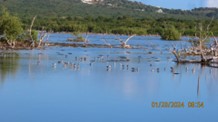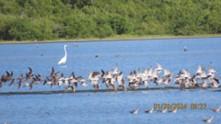BIRDING WITH THE TRUSTJanuary 20, 2024
- Rommel Santos

- Jan 25, 2024
- 2 min read
To promote interest in birds and bird conservation among members of the local community, the VCHT Birding Team offered a walk for Spanish speakers. It was held on Saturday, and Mark Martin was a leader and translator. Four visitors and one very enthusiastic community member joined Mike, Marie. Mark and Dale for what turned out to be an amazing birding experience.
Seven of us started on the Malecon at 7:30 a.m. We decided to go immediately to the Salitral, otherwise known as Sun Bay Lagoon. After parking the cars and heading to the lagoon, we met three other birders who decided to join us.
Carrying the scope, Mike lead the way to the lagoon. We never know what will be there. Today was a WOW. We found many flocks of Stilt Sandpipers feeding in the shallow water. Counting by groups of 10, we estimated 260 birds.

Stilt Sandpipers and a Great Egret
Almost immediately, Marie spotted a Black-crowned Night Heron, and Mike pointed out a
Tri-colored Heron, a Green Heron and a Clapper Rail. With the scope we counted 22 Great Egrets, 4 Brown Pelicans, 1 Great Blue Heron, and 1 Little Blue Heron feeding at the east end of the lagoon. A Belted Kingfisher perched on a dead mangrove limb.
11 White-cheeked Pintail Ducks cruised out in the lagoon. Three flocks of peeps (shorebirds that we couldn’t ID) flashed on the far shore. Counting by tens, the estimate was 320 birds. A Magnificent Frigatebird circled overhead.

Egrets and Brown Pelicans find food and shelter among dead mangroves.

Little Blue Heron
Hearing its distinctive call, some saw a Mangrove Cuckoo in the nearby bushes where we also caught sight of a Yellow Warbler, 5 Gray Kingbirds, 1 Logger-headed Kingbird, and 2 Greater Antillean Grackles.

Logger-headed Kingbird
The variety of species and the high number of shorebirds that we saw confirms our belief that the Salitral is an important habitat for both migrating and endemic birds. Stilt Sandpipers are long distance flyers. After wintering in the Caribbean and South America, they head north through the central U.S. to the sub-Arctic tundra in Canada and Alaska where they mate, nest, care for their young, and begin to molt. By early-July they leave the nesting area, gather in loose flocks and eventually make their way back through the central U.S. and return to their winter-feeding grounds. For some it’s Sun Bay lagoon.
We thank Mark Martin for his help on this walk and for his enthusiasm and support for bird conservation. We are excited to have Olga Felix join the team and Bird Committee. Thank you for supporting the Trust. We have several more walks scheduled between now and the end of March. They are January 24, February 7, February 21, March 6, and March 20. Join us again if you can.








Comments